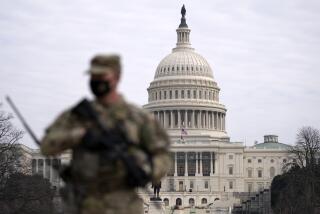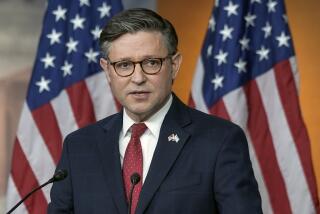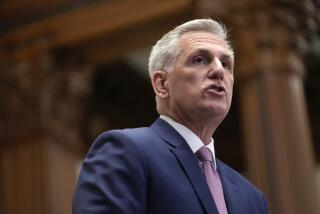House Democrats Decide ‘Air Foley’ Doesn’t Fly
- Share via
WASHINGTON — Hit by flak from Administration officials and others, House Democratic leaders Wednesday grounded an effort to create a one-plane air force commanded by Speaker Thomas S. Foley (D-Wash.).
The leaders dropped the plan to put a $19-million military jet under control of the Speaker after presidential spokesman Marlin Fitzwater called it a “foolish idea” and others ridiculed it as “Air Foley” and “Foley’s Royal Air Force.”
The proposal suddenly appeared in a compromise $285.8-billion defense spending measure crafted by House and Senate negotiators. Foley claimed to be surprised by the provision, which was tucked into the bill by Rep. John P. Murtha (D-Pa.), apparently without the knowledge of most other negotiators.
Murtha said that the military aircraft would give Foley needed protection from terrorists. Rep. Charles Wilson (D-Tex.), a chief advocate of the proposal, added that it would help lawmakers avoid flying corporate planes and thus would help them avoid conflict-of-interest charges.
Disposal of the plan means that lawmakers will continue the current practice of requesting a plane from the Air Force when one is needed.
The timing of the proposal was awkward for Foley, who is pushing a 33% pay raise and ethics package for House members in a vote scheduled for today.
The defense appropriation measure approved by the House and sent to the Senate for final action calls for spending nearly $286 billion in the fiscal year that began Oct. 1.
That represents a $3.4-billion increase over last year and is $2.4 billion less than President Bush requested.
The bill closely conforms to a funding authorization measure that won final congressional approval by the Senate Wednesday.
The $3.8 billion approved for “Star Wars,” the Strategic Defense Initiative, is a reduction of 22% from Bush’s request of $4.9 billion. Although Congress has slashed the “Star Wars” funding request each year beginning in 1986, this is the first time that the budget for the anti-missile research program has been reduced below the previous year’s level.
The legislation also provides $4.3 billion of the $4.7 billion requested to continue production of the B-2 Stealth bomber--enough to buy two planes in fiscal 1990 and components that could be used for five additional planes scheduled for inclusion in the fiscal 1991 budget.
More to Read
Get the L.A. Times Politics newsletter
Deeply reported insights into legislation, politics and policy from Sacramento, Washington and beyond. In your inbox twice per week.
You may occasionally receive promotional content from the Los Angeles Times.










